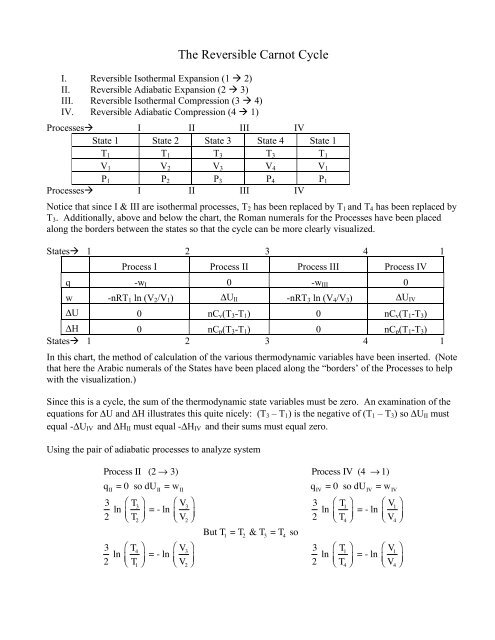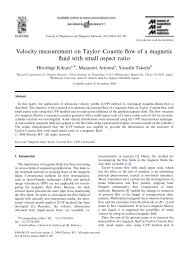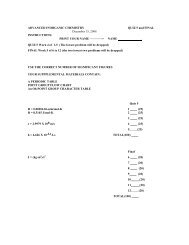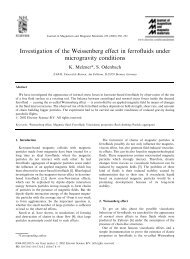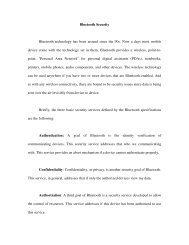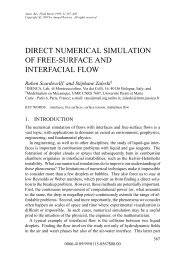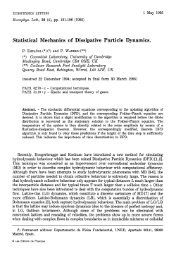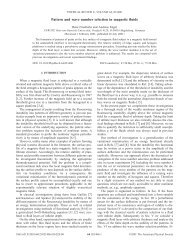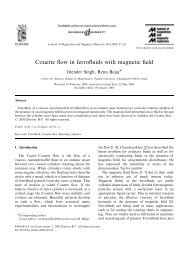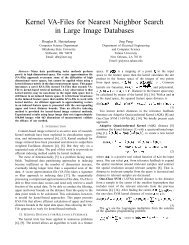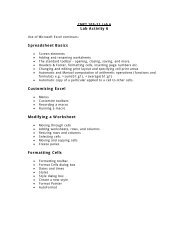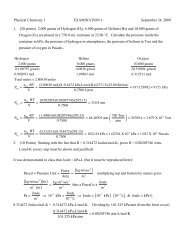The Reversible Carnot Cycle
The Reversible Carnot Cycle
The Reversible Carnot Cycle
You also want an ePaper? Increase the reach of your titles
YUMPU automatically turns print PDFs into web optimized ePapers that Google loves.
<strong>The</strong> <strong>Reversible</strong> <strong>Carnot</strong> <strong>Cycle</strong><br />
I. <strong>Reversible</strong> Isothermal Expansion (1 2)<br />
II. <strong>Reversible</strong> Adiabatic Expansion (2 3)<br />
III. <strong>Reversible</strong> Isothermal Compression (3 4)<br />
IV. <strong>Reversible</strong> Adiabatic Compression (4 1)<br />
Processes I II III IV<br />
State 1 State 2 State 3 State 4 State 1<br />
T1 T1 T3 T3 T1<br />
V1 V2 V3 V4 V1<br />
P1 P2 P3 P4 P1<br />
Processes I II III IV<br />
Notice that since I & III are isothermal processes, T2 has been replaced by T1 and T4 has been replaced by<br />
T3. Additionally, above and below the chart, the Roman numerals for the Processes have been placed<br />
along the borders between the states so that the cycle can be more clearly visualized.<br />
States 1 2 3 4 1<br />
Process I Process II Process III Process IV<br />
q -wI 0 -wIII 0<br />
w -nRT1 ln (V2/V1) ΔUII -nRT3 ln (V4/V3) ΔUIV<br />
ΔU 0 nCv(T3-T1) 0 nCv(T1-T3)<br />
ΔH 0 nCp(T3-T1) 0 nCp(T1-T3)<br />
States 1 2 3 4 1<br />
In this chart, the method of calculation of the various thermodynamic variables have been inserted. (Note<br />
that here the Arabic numerals of the States have been placed along the “borders’ of the Processes to help<br />
with the visualization.)<br />
Since this is a cycle, the sum of the thermodynamic state variables must be zero. An examination of the<br />
equations for ΔU and ΔH illustrates this quite nicely: (T3 – T1) is the negative of (T1 – T3) so ΔUII must<br />
equal -ΔUIV and ΔHII must equal -ΔHIV and their sums must equal zero.<br />
Using the pair of adiabatic processes to analyze system<br />
Process II (2 ! 3) Process IV (4 ! 1)<br />
q II = 0 so dU II = w II q IV = 0 so dU IV = w IV<br />
3<br />
2 ln T " % 3<br />
#<br />
$<br />
&<br />
' = - ln V " % 3<br />
#<br />
$<br />
&<br />
' 3<br />
2 ln T " % 1<br />
#<br />
$<br />
&<br />
' = - ln V " % 1<br />
#<br />
$<br />
&<br />
'<br />
T 2<br />
V 2<br />
But T 1 = T 2 & T 3 = T 4 so<br />
3<br />
2 ln T ! $ 4<br />
"<br />
#<br />
%<br />
& = - ln V ! $ 3<br />
"<br />
#<br />
%<br />
& 3<br />
2 ln T ! $ 1<br />
"<br />
#<br />
%<br />
& = - ln V ! $ 1<br />
"<br />
#<br />
%<br />
&<br />
T 1<br />
V 2<br />
T 4<br />
T 4<br />
V 4<br />
V 4
and that means ln V ! $ 3<br />
"<br />
#<br />
%<br />
& = - ln V ! $ 1<br />
"<br />
#<br />
%<br />
&<br />
V 2<br />
which rearranges to V ! $ 3<br />
"<br />
#<br />
%<br />
& = V ! $ 4<br />
"<br />
#<br />
%<br />
& ' V ! $ 1<br />
"<br />
#<br />
%<br />
& = V ! $ 4<br />
"<br />
#<br />
%<br />
& or V ! $ 2<br />
"<br />
#<br />
%<br />
& = V ! $ 3<br />
"<br />
#<br />
%<br />
&<br />
V 2<br />
V 1<br />
Since the total work is {-nRT1 ln (V2/V1)} + {-nRT3 ln (V4/V3)} & ln (V2/V1) = - ln (V4/V3)<br />
<strong>The</strong>n<br />
-nR T1 ln V ' ! $ * 2<br />
)<br />
"<br />
# V1 %<br />
& , + -nR T3 ln<br />
(<br />
+<br />
V ' ! $ * 4<br />
)<br />
"<br />
# V3 %<br />
& , = -nR T1 ln<br />
(<br />
+<br />
V ' ! $ * 2<br />
)<br />
"<br />
# V1 %<br />
& , + +nR T3 ln<br />
(<br />
+<br />
V ' ! $ * 2<br />
)<br />
"<br />
# V1 %<br />
& ,<br />
(<br />
+<br />
work total = T 3 - T 1<br />
'<br />
)<br />
(<br />
V 2<br />
!<br />
"<br />
#<br />
V 4<br />
( ) nR ln V 2<br />
and because T1 ≠ T3. Thus, the net total work for the cycle cannot be ZERO<br />
HOMEWORK PROBLEM<br />
V1 = n RT1 =<br />
P1 (1.000)(8.31447)(300.0)<br />
! V1 = 24.94341 Liters<br />
100.0<br />
Processes I II III IV<br />
State 1 State 2 State 3 State 4 State 1<br />
Temperature (K) 300.0 300.0 100.0 100.0 300.0<br />
Volume (Liters) 24.94 V2 V3 V4 24.94<br />
Pressure (kPa) 100.0 P2 P3 P4 100.0<br />
Processes I II III IV<br />
States 1 2 3 4 1<br />
Process I Process II Process III Process IV<br />
q 2.500 0 -wIII 0<br />
w -2.500 ΔUII -nRT3 ln (V4/V3) ΔUIV<br />
ΔU 0 nCv(T3-T1) 0 nCv(T1-T3)<br />
ΔH 0 nCp(T3-T1) 0 nCp(T1-T3)<br />
States 1 2 3 4 1<br />
Just like above, use the adiabatic process to identify the states (starting with IV)<br />
Process IV (4 ! 1)<br />
q IV = 0 so dU IV = w IV " 3<br />
2<br />
# 100.0 &<br />
ln<br />
$<br />
%<br />
300.0'<br />
( = - ln 24.94341 # &<br />
$<br />
%<br />
'<br />
(<br />
V 4<br />
V 1<br />
V 3<br />
$ *<br />
%<br />
& ,<br />
+<br />
V 1<br />
V 4
ln 24.94341 ! $<br />
! 24.94341$<br />
"<br />
#<br />
%<br />
& = -1.647918 &<br />
"<br />
#<br />
%<br />
& = 0.192645 & V4 = 129.60976 Liters<br />
V 4<br />
P 4 = n RT 4<br />
V 4<br />
= (1.000)(8.31447)(100.0)<br />
129.60976<br />
Now the first table looks like this<br />
V 4<br />
' P 4 = 6.41500 kPa<br />
Processes I II III IV<br />
State 1 State 2 State 3 State 4 State 1<br />
Temperature (K) 300.0 300.0 100.0 100.0 300.0<br />
Volume (Liters) 24.93 V2 V3 129.6 24.93<br />
Pressure (kPa) 100.0 P2 P3 6.415 100.0<br />
Processes I II III IV<br />
Since wI = -2.500 kJ , wI = - n RT1 ln V ! $ 2<br />
"<br />
#<br />
%<br />
& and V1 = 24.9434, V2 = 67.95719 Liters<br />
P 2 = n RT 2<br />
V 2<br />
V 1<br />
= (1.000)(8.31447)(300.0)<br />
67.95719<br />
! P 2 = 36.70459 kPa<br />
<strong>The</strong> above proof shows that ln V ! $ 3<br />
"<br />
#<br />
%<br />
& = - ln V ! $ 1<br />
"<br />
#<br />
%<br />
& that means V ! $ 3<br />
"<br />
#<br />
%<br />
& = V ! $ 4<br />
"<br />
#<br />
%<br />
And finally P 3 = n RT 3<br />
V 3<br />
V 2<br />
V 4<br />
= (1.000)(8.31447)(100.0)<br />
353.1305<br />
V 2<br />
! P 3 = 2.35450 kPa<br />
V &<br />
1<br />
& V3 = 353.1305 Liters<br />
Processes I II III IV<br />
State 1 State 2 State 3 State 4 State 1<br />
Temperature (K) 300.0 300.0 100.0 100.0 300.0<br />
Volume (Liters) 24.93 67.96 353.1 129.6 24.93<br />
Pressure (kPa) 100.0 36.70 2.355 6.415 100.0<br />
Processes I II III IV<br />
States 1 2 3 4 1<br />
Process I Process II Process III Process IV<br />
q 2.500 0 -0.83334 0<br />
w -2.500 -2.494 0.83334 2.494<br />
ΔU 0 -2.494 0 2.494<br />
ΔH 0 -4.157 0 4.157<br />
States 1 2 3 4 1


